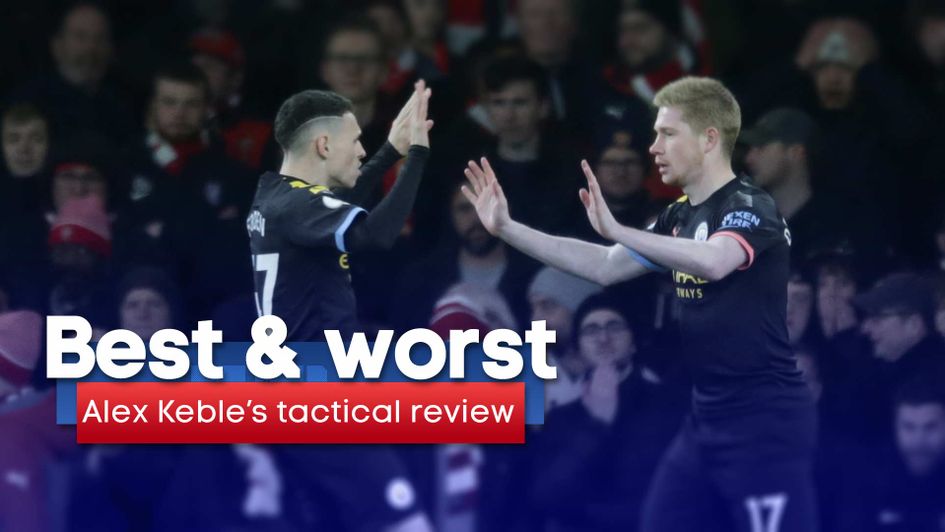Alex Keble picks out the best and worst from the Premier League weekend, including Manchester City's new dynamic midfield duo and Duncan Ferguson's big decisions.
- Follow Alex Keble on Twitter
- Arsenal urged to make a decision
- Watch: Ferguson's Everton draw at Old Trafford
- Watch: Easy for City at Arsenal
Best
Foden & De Bruyne partnership in a new Guardiola system
Man City’s creativity issues over the last few weeks stem from having emptied midfield. Kevin de Bruyne sits too far out to the right, Rodri can’t control the tempo on his own like Fernandinho could, and David Silva is too far forward. And so the significant tactical change made for the trip to Arsenal were timely. Pep Guardiola selected a 4-2-3-1 with two holding midfielders, Kevin de Bruyne properly in the middle, and Phil Foden drifting in from the left.
2️⃣ Two goals
— Sporting Life Football (@SportingLifeFC) December 15, 2019
1️⃣ One assist
😩 Inches away from a hat-trick
👏 What an afternoon this has been so far for Kevin De Bruyne! #ARSMCI | #MCFC pic.twitter.com/dPDpNtHHMl
Foden, De Bruyne, Rodri, and Ilkay Gundogan formed a quartet that overwhelmed Arsenal’s soft midfield, with intelligent forward passes from the two at the base catching Arsenal’s hazardously disunited press (most notably instigating the counter-attack for the second goal). De Bruyne was the standout player, of course, and it is no coincidence he was playing more through the centre than at any other point this season. Foden’s movement certainly helped, not least in the creation of the third goal.
It might be time for Guardiola to regularly play inverted wingers, put De Bruyne in a simple number ten, and leave David Silva on the bench.
Ferguson’s wild decisions make Everton great fun for neutrals
There is something intoxicating about Duncan Ferguson’s frenzied start to life as interim Everton manager. Whether it’s jumping around on the touchline, wearing nothing but a shirt in the wind and rain, lying about what formation he’s using, picking every attacker he possibly can, or making bemusing substitutions, Ferguson is enjoyably bonkers.
Before kick-off the Everton Twitter account suggested Ferguson had plumped for a 3-1-5, Tom Davies sat within a circle. Fans will have been relieved to see Mason Holgate move into central midfield once the game was underway, and Everton were once again in a conventional 4-4-2. Then again, it still wasn’t ordinary; Ferguson had at least four forwards on the pitch at any given time and managed to get through four strikers in 90 minutes.
👀 Big Dunc's Everton are so good right now that even Victor Lindelof wants to score for them!
— Sporting Life Football (@SportingLifeFC) December 15, 2019
🍬 The Toffees take the lead at Old Trafford!#MUNEVE | #EFC pic.twitter.com/gu20JKflXQ
Which brings us onto his treatment of Moise Kean; the 19-year-old was subbed after just 18 minutes, walking off down the tunnel without so much as a handshake from his manager. Some have said this was a much-needed stern message for a player who wasn’t following instructions, but surely a teenager in a new country needs an arm around the shoulder, not a public humiliation. Considering the club spent a lot of money to make this statement signing, when push comes to shove they will back Kean over Ferguson. The manager had better hope his trick sparks a positive reaction.
Late winner shows Mourinho is the antidote to ‘Spursy’ tendencies
Having been outplayed and outfought for long periods in the wind and rain, the last thing we would have expected from a Mauricio Pochettino team is a late winner – and from a good old fashioned set-piece, no less. But under Jose Mourinho Tottenham already appear to have more resolve and more self-belief, on Sunday winning a tricky away game that – were we at the start of a season – would be hailed as a performance of potential champions.
Winning ugly is a difficult skill to develop, and a hallmark of Mourinho teams. Other hallmarks include long passing, quick counters, individualistic dribbling (see Lucas’s opener), and standing off rather than pressing. All of these were in force at Wolves as Spurs bucked the trend by leaving the Midlands with just 42% possession. Wolves average at home is 50%, and against ‘Big Six’ teams that drops to 36.6%.
Worst
A nine-goal Saturday shows the league lacks quality
There were a grand total of nine goals scored in six matches on Saturday. Only seven Premier League clubs actually scored. Nobody did so more than twice. Three of the games – at Sheffield United, Burnley, and Southampton – were contenders for worst match of the season so far.
What happened? It could just be coincidence, of course, but more likely this has something to do with the time of year. The cold and the rain were a factor, plus in the middle of the busy December schedule a lot of teams have begun rotating their first 11s, which inevitably means the football is less fluid. There’s also the added tension surrounding managers under pressure… and the fact Premier League football isn’t all that good outside the top half.
West Ham and Southampton are both pretty terrible at the moment, ditto Aston Villa, Burnley, Watford, and Newcastle. Sometimes the fixture list conspires to throw up a dud round. Next weekend – with Everton v Arsenal, Man City v Leicester, and Spurs v Chelsea – should be much better.
VAR decisions infuriate yet again
We got another two reasons to hate VAR this weekend, but only one of them has received mainstream attention. Sadio Mane’s disallowed goal, thanks to his hip adjudged to be offside by a single millimetre, rightly drew criticism. Many people are angry just because it seems somehow morally wrong – against the spirit of the game – to so strictly magnify these events, slowing the game down and ruining a goal everybody was perfectly happy with before VAR came in.
Here's the VAR freeze-frame of the Bournemouth winner against Chelsea. That ball isn't even round, therefore this is not a reliable frame.
— Alex Keble (@alexkeble) December 15, 2019
You cannot say, for certain, this has captured the moment the pass was made... and so you cannot overrule the linesman pic.twitter.com/yVSfIwLtlc
It’s a good point, but even by VAR’s own measures the goal should have stood. The frame rate of these cameras means we can only guarantee accuracy to around 20-30mm, meaning a call as tight as that one is null and void. The technology is inherently unreliable.
Secondly, the frame-rate issue means it is hard to know exactly when to stop the video or where exactly to place the pointers on the players’ body parts (which is done manually before the computer joins up the dots). This was equally important for a VAR decision to allow Bournemouth’s goal at Chelsea, which has largely been seen as the correct call. But look at the freeze frame used for the decision: that ball is an oval shape. We cannot guarantee this is the precise moment the ball hit the head. If we cannot be sure, the original offside decision should stand.
This is excruciatingly pedantic, but we’ve been drawn down to their level. The technology doesn’t exist. The system has to go.
Aston Villa need a rethink as rivals improve
Villa have now lost three matches on the trot and find themselves outside the relegation zone on goal difference alone. Dean Smith’s tactics have simply been too consistent, and opponents have begun to work out how to nullify it – while the players themselves look creatively blunted by the too-familiar rhythms of their passing. It’s the football equivalent of writer’s block.
Sticking Jack Grealish right out on the left wing certainly didn’t help in Saturday’s 2-0 defeat at Sheffield United, but their problems run deeper than how Grealish is performing this month. Villa could do with a major shake-up, and switching to a narrow 3-4-2-1 might do the trick.
In this system, popularised by Antonio Conte at Chelsea, Wesley could get the close support he craves from two inside forwards (Grealish and one other) while a back three would stiffen up a problem area for Smith. What’s more, Matt Targett and Frederic Guilbert are better going forward than defending, and so would suit wing-back roles.
Smith has to do something, because unless Villa get six points from their next two – crucial home ties against Southampton and Norwich – they will be favourites for the drop.









